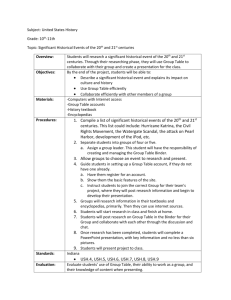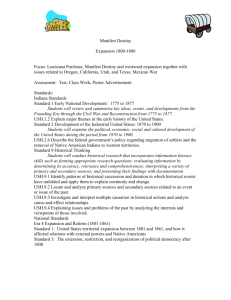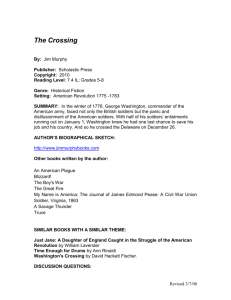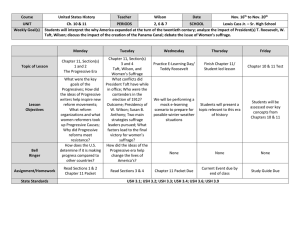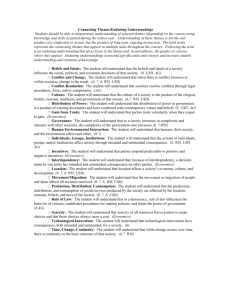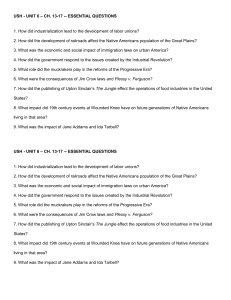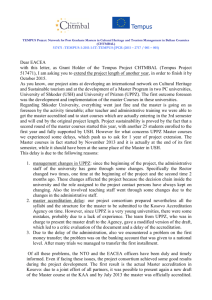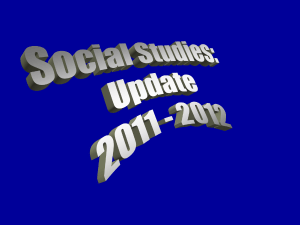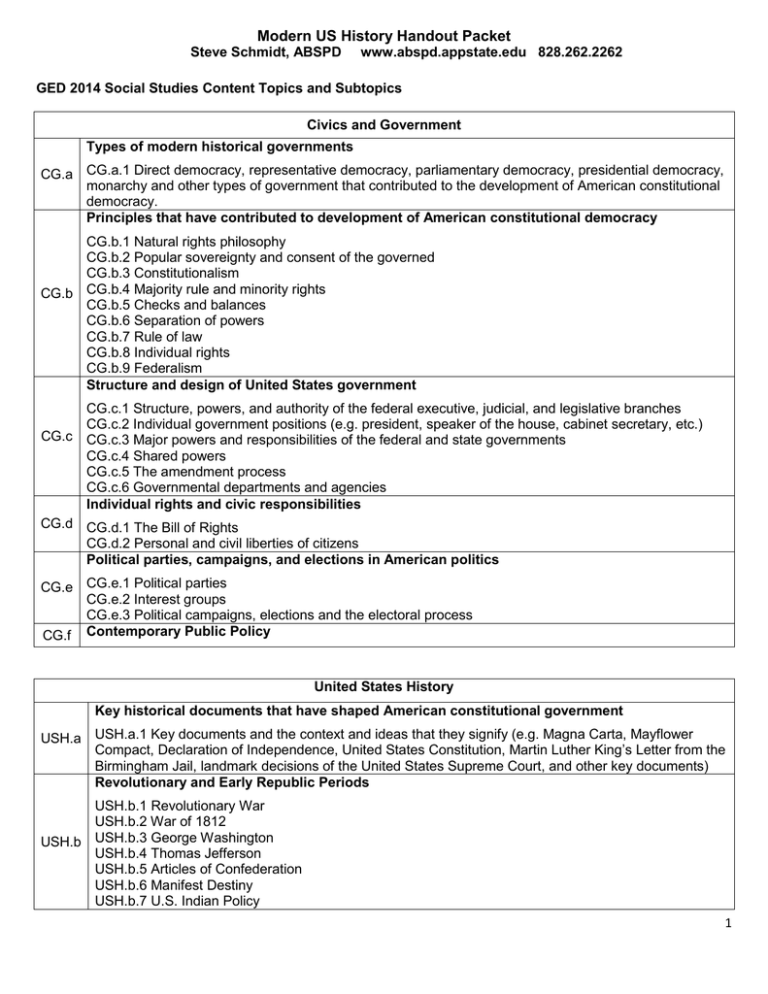
Modern US History Handout Packet
Steve Schmidt, ABSPD
www.abspd.appstate.edu 828.262.2262
GED 2014 Social Studies Content Topics and Subtopics
Civics and Government
Types of modern historical governments
CG.a CG.a.1 Direct democracy, representative democracy, parliamentary democracy, presidential democracy,
monarchy and other types of government that contributed to the development of American constitutional
democracy.
Principles that have contributed to development of American constitutional democracy
CG.b.1 Natural rights philosophy
CG.b.2 Popular sovereignty and consent of the governed
CG.b.3 Constitutionalism
CG.b CG.b.4 Majority rule and minority rights
CG.b.5 Checks and balances
CG.b.6 Separation of powers
CG.b.7 Rule of law
CG.b.8 Individual rights
CG.b.9 Federalism
Structure and design of United States government
CG.c
CG.c.1 Structure, powers, and authority of the federal executive, judicial, and legislative branches
CG.c.2 Individual government positions (e.g. president, speaker of the house, cabinet secretary, etc.)
CG.c.3 Major powers and responsibilities of the federal and state governments
CG.c.4 Shared powers
CG.c.5 The amendment process
CG.c.6 Governmental departments and agencies
Individual rights and civic responsibilities
CG.d CG.d.1 The Bill of Rights
CG.d.2 Personal and civil liberties of citizens
Political parties, campaigns, and elections in American politics
CG.e CG.e.1 Political parties
CG.e.2 Interest groups
CG.e.3 Political campaigns, elections and the electoral process
CG.f Contemporary Public Policy
United States History
Key historical documents that have shaped American constitutional government
USH.a USH.a.1 Key documents and the context and ideas that they signify (e.g. Magna Carta, Mayflower
Compact, Declaration of Independence, United States Constitution, Martin Luther King’s Letter from the
Birmingham Jail, landmark decisions of the United States Supreme Court, and other key documents)
Revolutionary and Early Republic Periods
USH.b.1 Revolutionary War
USH.b.2 War of 1812
USH.b USH.b.3 George Washington
USH.b.4 Thomas Jefferson
USH.b.5 Articles of Confederation
USH.b.6 Manifest Destiny
USH.b.7 U.S. Indian Policy
1
Civil War and Reconstruction
USH.c
USH.c.1 Slavery
USH.c.2 Sectionalism
USH.c.3 Civil War Amendments
USH.c.4 Reconstruction policies
Civil Rights
USH.d.1 Jim Crow laws
USH.d USH.d.2 Women’s suffrage
USH.d.3 Civil Rights Movement
USH.d.4 Plessy vs. Ferguson and Brown vs. Board of Education
USH.d.5 Warren court decisions
USH.e European settlement and population of the Americas
World Wars I & II
USH.f
USH.f.1 Alliance system
USH.f.2 Imperialism, nationalism, and militarism
USH.f.3 Russian Revolution
USH.f.4 Woodrow Wilson
USH.f.5 Treaty of Versailles and League of Nations
USH.f.6 Neutrality Acts
USH.f.7 Isolationism
USH.f.8 Allied and Axis Powers
USH.f.9 Fascism, Nazism, and totalitarianism
USH.f.10 The Holocaust
USH.f.11 Japanese-American internment
USH.f.12 Decolonization
USH.f.13 GI Bill
The Cold War
USH.g.1 Communism and capitalism
USH.g.2 NATO and the Warsaw Pact
USH.g.3 U.S. maturation as an international power
USH.g USH.g.4 Division of Germany, Berlin Blockade and Airlift
USH.g.5 Truman Doctrine
USH.g.6 Marshall Plan
USH.g.7 Lyndon B. Johnson and The Great Society
USH.g.8 Richard Nixon and the Watergate scandal
USH.g.9 Collapse of U.S.S.R and democratization of Eastern Europe
USH.h American foreign policy since 9/11
Economics
E.a
Key economic events that have shaped American government and policies
E.b
Relationship between political and economic freedoms
Fundamental Economic Concepts
E.c
E.c.1 Markets
E.c.2 Incentives
E.c.3 Monopoly and competition
E.c.4 Labor and capital
E.c.5 Opportunity cost
2
E.c.6 Profit
E.c.7 Entrepreneurship
E.c.8 Comparative advantage
E.c.9 Specialization
E.c.10 Productivity
E.c.11 Interdependence
Microeconomics and Macroeconomics
E.d
E.d.1 Supply, demand and price
E.d.2 Individual choice
E.d.3 Institutions
E.d.4 Fiscal and monetary policy
E.d.5 Regulation and costs of government policies
E.d.6 Investment
E.d.7 Government and market failures
E.d.8 Inflation and deflation
E.d.9 GDP
E.d.10 Unemployment
E.d.11 Tariffs
Consumer economics
E.f
E.e.1 Types of credit
E.e.2 Savings and banking
E.e.3 Consumer credit laws
Economic causes and impacts of wars
E.g
Economic drivers of exploration and colonization
E.h
Scientific and Industrial Revolutions
E.e
Geography
G.a
Development of classical civilizations
Relationships between the environment and societal development
G.b
G.b.1 Nationhood and statehood
G.b.2 Sustainability
G.b.3 Technology
G.b.4 Natural resources
G.b.5 Human changes to the environment
Borders between peoples and nations
G.c
G.c.1 Concepts of region and place
G.c.2 Natural and cultural diversity
G.c.3 Geographic tools and skills
Human Migration
G.d
G.d.1 Immigration, emigration and diaspora
G.d.2 Culture, cultural diffusion and assimilation
G.d.3 Population trends and issues
G.d.4 Rural and urban settlement
3
References to
Common Core
State Standards,
NCSS, and NSH
R.1, R.8
Social Studies Practices
SSP.1 Drawing Conclusions and Making Inferences
a. Determine the details of what is explicitly stated in primary
and secondary sources and make logical inferences or valid
claims based on evidence.
b. Cite or identify specific evidence to support inferences or
analyses of primary and secondary sources, attending to the
precise details of explanations or descriptions of a process,
event, or concept.
R.2, NCSS
Literacy Skills
1-3
2-3
1-2
2-3
2-3
2-3
SSP.4 Interpreting Meaning of Symbols, Words and Phrases
a. Determine the meaning of words and phrases as they are
used in context, including vocabulary that describes
historical, political, social, geographic, and economic aspects
of social studies.
R.6, NSH 3.F
1-3
SSP.3 Analyzing Events and Ideas
a. Identify the chronological structure of a historical narrative
and sequence steps in a process.
b. Analyze in detail how events, processes, and ideas develop
and interact in a written document; determine whether the
earlier events caused later ones or simply preceded them.
c. Analyze cause-and-effect relationships and multiple
causation, including action by individuals, natural and societal
processes, and the influence of ideas.
d. Compare differing sets of ideas related to political, historical,
economic, geographic, or societal contexts; evaluate the
assumptions and implications inherent in differing positions.
R.4.2, L.4.2
2-3
SSP.2 Determining Central Ideas, Hypotheses and
Conclusions
a. Determine the central ideas or information of a primary or
secondary source document, corroborating or challenging
conclusions with evidence.
b. Describe people, places, environments, processes, and
events, and the connections between and among them.
R.3, R.8
Depth of
Knowledge
(DOK) level
range
1-3
SSP.5 Analyzing Purpose and Point of View
a. Identify aspects of a historical document that reveal an
author’s point of view or purpose (e.g., loaded language,
inclusion or avoidance of particular facts).
b. Identify instances of bias or propagandizing.
c. Analyze how a historical context shapes an author’s point of
view.
d. Evaluate the credibility of an author in historical and
contemporary political discourse.
2
2-3
2-3
2-3
4
References to
Common Core
State Standards,
NCSS, and NSH
R.9.1, R.7.1,
R.7.2, Q7: 7.RP.,
3.MD.3, S-ID.1,
8.SP.1, S-ID.6, SID.7, NSH 2
SSP.6 Integrating Content Presented in Different Ways
R.8, NSH 3.E
SSP.7 Evaluating Reasoning and Evidence
Social Studies Practices
2-3
a. Integrate quantitative or technical analysis (e.g., charts,
research data) with qualitative analysis in print or digital text.
2-3
b. Analyze information presented in a variety of maps, graphic
organizers, tables, and charts; and in a variety of visual
sources such as artifacts, photographs, political cartoons.
1-3
c. Translate quantitative information expressed in words in a
text into visual form (e.g., table or chart); translate information
expressed visually or mathematically into words.
a. Distinguish among fact, opinion, and reasoned judgment in a
primary or secondary source document.
b. Distinguish between unsupported claims and informed
hypotheses grounded in social studies evidence.
R.9, R.7
Q.7: 7.RP.,
3.MD.3, S-ID.1,
8.SP.1, S-ID.6,
S-ID.7
Q8: 6.SP.3, SMD.2, 6.SP.2,
6.SP.5, S-ID.2,
2-3
2-3
SSP.8 Analyzing Relationships between Texts
a. Compare treatments of the same social studies topic in
various primary and secondary sources, noting discrepancies
between and among the sources.
R.1, W.1, W.2,
W.4, W.5, L.1,
L.2, L.4
Range of
Depth of
Knowledge
(DOK) levels
2-3
SSP.9 Writing Analytic Response to Source Texts
a. Produce writing that develops the idea(s), claim(s) and/or
argument(s) thoroughly and logically, with well-chosen
examples, facts, or details from primary and secondary
source documents.
b. Produce writing that introduces the idea(s) or claim(s) clearly;
creates an organization that logically sequences information;
and maintains a coherent focus.
c. Write clearly and demonstrate sufficient command of
standard English conventions.
2-3
2-3
1-2
SSP.10 Reading and Interpreting Graphs, Charts and Other
Data Representation
a. Interpret, use, and create graphs (e.g., scatterplot, line, bar,
circle) including proper labeling. Predict reasonable trends
based on the data (e.g., do not extend trend beyond a
reasonable limit).
b. Represent data on two variables (dependent and
independent) on a graph; analyze and communicate how the
variables are related.
c. Distinguish between correlation and causation.
2-3
2-3
1-3
SSP.11 Measuring the Center of a Statistical Dataset
a. Calculate the mean, median, mode, and range of a dataset
1
5
GED 2014 Focusing Themes
Social Studies Topic Matrix
Focusing Themes
I. Development
of Modern
Liberties and
Democracy
CG: Civics and
Government (50%)
USH: U.S. History
(20%)
a. Types of modern
and historical
governments
a. Key historical
documents that
have shaped
American
constitutional
government
b. Principles that
have contributed
to development
of American
constitutional
democracy
c. Structure and
design of United
States
government
b. Revolutionary
and Early
Republic Periods
E: Economics (15%)
G: Geography and
the World (15%)
a. Key economic
a. Development of
events that have
classical
shaped American
civilizations
government and
policies
b. Relationship
between political
and economic
freedoms
c. Civil War &
Reconstruction
d. Civil Rights
Movement
d. Individual rights
and civic
responsibilities
II. Dynamic
Responses in
Societal Systems
e. Political parties,
campaigns, and
elections in
American politics
e. European
c. Fundamental
population of the
economic
Americas
concepts
f. Contemporary
public policy
g. The Cold War
f. World War I & II
h. American foreign
policy since 9/11
d. Microeconomics
and
macroeconomics
e. Consumer
economics
f. Economic causes
and impacts of
wars
b. Relationships
between the
environment and
societal
development
c. Borders between
peoples and
nations
d. Human
migration
g. Economic drivers
of exploration
and colonization
h. Scientific and
Industrial
Revolutions
6
Webb’s Depth of Knowledge
Depth of Knowledge Level Descriptors for Social Studies
Level 1
Recall of Information
a. Recall or recognition
of: fact, term,
concept, trend,
generalization,
event, or document
b. Identify or describe
features of places or
people
c. Identify key figures
in a particular
context meaning of
words
d. Describe or explain:
who, what, where,
when
e. Identify specific
information
contained in maps,
charts, tables,
graphs, or drawings
Level 2
Basic Reasoning
a. Describe causeeffect of particular
events
b. Describe or explain:
how (relationships
or results), why,
points of view,
processes,
significance, or
impact
c. Identify patterns in
events or behavior
d. Categorize events or
figures in history
into meaningful
groups
e. Identify and
summarize the
major events,
problem, solution,
conflicts
f. Distinguish between
fact and opinion
g. Organize
information to show
relationships
h. Compare and
contrast people,
events, places,
concepts
i.
Level 3
Complex Reasoning
a. Explain, generalize,
or connect ideas,
using supporting
evidence from a
text/source
b. Apply a concept in
other contexts
Level 4
Extended Reasoning
a. Analyze and explain
multiple
perspectives or
issues within or
across time periods,
events, or cultures
c. Make and support
inferences about
implied causes and
effects
b. Gather, analyze,
organize, and
synthesize
information from
multiple (print and
non-print) sources
d. Draw conclusions or
form alternative
conclusions
c. Make predictions
with evidence as
support
e. Analyze how
changes have
affected people or
places
d. Plan and develop
solutions to
problems
f. Use concepts to
solve problems
g. Analyze similarities
and differences in
issues or problems
h. Propose and
evaluate solutions
i.
Recognize and
explain
misconceptions
related to concepts
e. Given a
situation/problem,
research, define,
and describe the
situation/problem
and provide
alternative solutions
f. Describe, define,
and illustrate
common social,
historical, economic,
or geographical
themes and how
they interrelate
Give examples and
non-examples to
illustrate an
idea/concept
7
Comparing GED 2002 and 2014: Social Studies
GED 2002: Webb’s DOK Level _____
The question below refers to the following timeline:
100,000 Homo sapiens neanderthalensis: Neanderthal
35,000 Homo sapiens sapiens: Cro-Magnon
32,000 Flute: the first known musical instrument
29,000 Cave art
27,000 Figurines
23,000 Sewing needle
17,000 Spear-thrower
12,000 Bow and arrow
7,000 Ice Age ends: glaciers retreat
When Ice Age hunters invented the spear-thrower, they were able to hurl weapons faster and more
accurately than they could barehanded. How long ago is this innovation believed to have taken place?
A) 7,000 years ago
B) 17,000 years ago
C) 27,000 years ago
D) 10,000 years after the development of the sewing needle
E) 10,000 years before the development of the sewing needle
GED 2014: Webb’s DOK Level _____
The excerpt below is from a 1947 speech by President Harry Truman.
I am fully aware of the broad implications involved if the United States extends assistance to Greece and
Turkey . . .
One of the primary objectives of the foreign policy of the United States is the creation of conditions in
which we and other nations will be able to work out a way of life free from coercion. This was a
fundamental issue in the war with Germany and Japan. Our victory was won over countries which
sought to impose their will, and their way of life, upon other nations.
To ensure the peaceful development of nations, free from coercion, the United States has taken a
leading part in establishing the United Nations. The United Nations is designed to make possible lasting
freedom and independence for all its members. We shall not realize our objectives, however, unless we
are willing to help free peoples to maintain their free institutions and their national integrity against
aggressive movements that seek to impose upon them totalitarian regimes . . .
Based on the excerpt, why did the United States provide financial assistance to Greece and Turkey?
A) to eliminate public protests
B) to prevent government corruption
C) to uphold international agreements
D) to shape their foreign policy
8
GED 2014 Technology Skills
Keyboarding
Can your students:
☐ Type approximately 25 words per minute, fast enough to complete a 500 word constructed
response in 45 minutes?
☐ Use the keys: space bar, return/enter, shift, arrows, delete, backspace, tab?
☐ Use the numbers and punctuation keys?
Using a Mouse
Can your students use a mouse to:
☐
☐
☐
☐
☐
☐
☐
☐
☐
Point to an area or word on screen?
Left click, right click, double click?
Highlight and select text?
Cut, copy, and paste text?
Select an object or window by clicking on it?
Drag an object to a new location?
Open/close a pop-up window?
Select one or more radio and/or check buttons?
Scroll horizontally and vertically?
Navigation
Can your students:
☐
☐
☐
☐
☐
☐
Use the screen navigation commands previous/next?
Navigate multiple windows?
Navigate toolbars and drop-down menus?
Navigate screen tabs?
Use the undo and redo operations?
Mark a section/question as a “Flag for Review” and return to section/question as needed?
Free Technology Resources
GCF Learn Free
This free site guides students in learning how to use a mouse and computer basics as well as helping
students learn Microsoft Office applications like Word and Excel.
Google: gcf learn free or www.gcflearnfree.org
Typing Web
This free site helps students learn keyboarding. Instructors can register students to monitor their
progress
Google: typing web or www.typingweb.com
9
Social Studies Extended Response Scoring Rubric
Trait 1: Creation of Arguments and Use of Evidence
Description
Generates a text-based argument that demonstrates a clear understanding of
the historical relationships among ideas, events, and figures as presented in
the source text(s) and the contexts from which they are drawn
2
Cites relevant and specific evidence from primary and secondary source
text(s) that adequately supports an argument
Is well-connected to both the prompt and the source text(s)
Demonstrates an understanding of the relationships among ideas, events,
and figures as presented in the source text(s)
1
Cites some evidence from primary and secondary source texts in support of
an argument (may include a mix of relevant and irrelevant textual references)
Is connected to both the prompt and the source text(s)
Demonstrates minimal or no understanding of ideas, events, and figures
presented in the source texts or the contexts from which these texts are drawn
0
Cites minimal or no evidence from the primary and secondary source texts;
may or may not demonstrate an attempt to create an argument
Lacks connection either to the prompt or the source text(s)
Non-Scorable Responses (Score of 0/Condition Codes)
Response exclusively contains text copied from source text(s) or prompt
Response demonstrates that the test-taker has read neither the prompt nor the
sources text(s)
Response is incomprehensible
Response is not in English
Response has not been attempted (blank)
Score
Score
1
0
Trait 2: Development of Ideas and Organizational Structure
Description
Contains a sensible progression of ideas with understandable connections
between details and main ideas
Contains ideas that are developed and generally logical; multiple ideas are
elaborated upon
Demonstrates appropriate awareness of audience and the purpose of the
task
Contains an unclear or no apparent progression of ideas
Contains ideas that are insufficiently developed or illogical; just one idea is
elaborated upon
Demonstrates no awareness of the task
10
Score
1
Trait 3: Clarity and Command of Standard English Conventions
Description
Demonstrates adequate applications of conventions with specific regard to the
following skills:
1) Frequently confused words and homonyms, including contractions
2) Subject-verb agreement
3) Pronoun usage, including pronoun antecedent agreement, unclear pronoun
references, and pronoun case
4) Placement of modifiers and correct word order
5) Capitalization (e.g. proper nouns, titles, and beginnings of sentences)
6) Use of apostrophes with possessive nouns
7) Use of punctuation (e.g. commas in a series or in appositives and other nonessential elements, end marks, and appropriate punctuation for clause
separation)
Demonstrates largely correct sentence structure with variance from sentence to
sentence; is generally fluent and clear with specific regard to the following
skills:
1) Correct subordination, coordination and parallelism
2) Avoidance of wordiness and awkward sentence structures
3) Usage of transitional words, conjunctive adverbs and other words that
support logic and clarity
4) Avoidance of run-on sentences, fused sentences, or sentence fragments
5) Standard usage at a level of formality appropriate for on-demand, draft
writing
0
May contain some errors in mechanics and conventions, but they do not
interfere with understanding
Demonstrates minimal control of basic conventions with specific regard to skills
1-5 as listed in the first bullet under Trait 3, Score Point 2 above
Demonstrates consistently flawed sentence structure minimal or no variance
such that meaning may be obscured; demonstrates minimal control over skills 15 as listed in the second bullet under Trait 3, Score Point 2 above
Contains severe and frequent errors in mechanics and conventions that
interfere with comprehension
OR
Response is insufficient to demonstrate level of mastery over conventions and
usage
11
Social Studies Extended Response Prompt
Excerpt
“All, too, will bear in mind this sacred principle, that though the will of the majority is in all cases to prevail, that
will, to be rightful, must be reasonable; that the minority possess their equal rights, which equal laws must
protect, and to violate which would be oppression.”
-- Thomas Jefferson, 1801
Letter
June 15, 1943
To the Editor:
Students and teachers across this land say the pledge of allegiance each day to honor a republic committed to
liberty and justice for all. That commitment was reaffirmed yesterday by the Supreme Court’s ruling in West
Virginia State Board of Education v. Barnette. The ruling struck down as unconstitutional West Virginia’s directive
that schoolchildren must daily salute the flag while reciting the pledge of allegiance or face expulsion. The
Barnettes challenged the compulsory salute and pledge because it conflicts with their religious beliefs as
Jehovah’s Witnesses. Even so, the Court did not make its ruling based on freedom of religion. Instead, the
decision was based, in large part, on freedom of speech.
Our Constitution places certain rights beyond the reach of government officials and beyond the reach of what the
majority likes. The freedom of speech is certainly such a right. Yesterday’s ruling not only affirmed the freedom of
speech but expanded it to include the right not to speak. The Court has made clear that the government cannot
force people to say things they do not believe.
As our nation fights a worldwide war, it is natural to seek the reassurance that comes from a shared sense of
patriotism. As a society, we have looked to our public schools to help develop a love of a country in our young
people. But do we want patriotism that is “demonstrated” by government-mandated expressions of allegiance by
students (or any citizen)? Of course we do not!
We want a nation which commands our love and respect because the government does not infringe on personal
beliefs and protects the rights of all citizens. Yesterday’s ruling helps ensure that that is the type of nation in
which we and our children will live!
Amelia Parsons
Wheeling, West Virginia
In your response, develop an argument about how the author’s position in her letter reflects the
enduring issue expressed in the excerpt from Thomas Jefferson. Incorporate relevant and specific
evidence from the excerpt, the letter, and your own knowledge of the enduring issue and the
circumstances surrounding the case to support your analysis.
Type your response in the box. This task may require 25 minutes to complete.
12
Social Studies Extended Response Scoring Practice
Paper 1
In Amelia Parsons letter, she supports the decision of the Supreme Court’s ruling in West Virginia State
Board of Education v. Barnette. This decision ended a West Virginia mandate for all schoolchildren to
salute the flag and recite the pledge of allegiance or else face disciplinary action. In doing so, the
Supreme Court also upheld the freedom of speech in such a way that it allowed for a person’s right to
not speak. Parsons averred that it is important to have a government that not only protects our rights,
but that also does not “infringe on personal beliefs”. This sentiment is one repeated in an excerpt by
Thomas Jefferson that states that it is not just the majority that must be appeased in matters, but that
the minority possesses rights that must be equally protected n order to avoid oppression.
In West Virginia State Board of Education v. Barnette, the Barnettes appealed to the court to remove the
compulsory salute and pledge due to its conflict with their religious beliefs. The court did indeed overrule
the unconstitutional directive, basing its decision on the freedom of speech. Parsons states that the
freedom of speech is a right that cannot be controlled by the majority. She believes that no government
should enforce a law that oppresses a people, or one that makes people speak contrary to their beliefs.
Both Amelia Parsons and Thomas Jefferson have mentioned that, in maintaining what is right, our
government must see each individual as a significant voice and seek to exhibit the greatest liberty, so
long as it be reasonable.
Trait
Score Reason
1
2
1
0
2
1
0
3
1
0
Paper 2
Thomas Jefferson expressed in 1801 that all people, including those in the minority, should have “equal
rights, which equal laws must protect” and anything less would be oppression; he considered this to be a
“sacred principle.” In Amelia Parsons’ 1943 Letter to the Editor, more than 100 years after Thomas
Jefferson expressed his opinion on the subject, she details the exact same sentiments about a court
decision that had just taken place. In West Virginia State Board of Education v. Barnette, the Supreme
Court ruled that children would not be forced to say the pledge of allegiance if they did not want to.
Apparently, the decision did not stem so much from the Court’s desire to protect freedom of religion, but
rather to protect freedom of speech. As Amelia states in her letter, “[the] ruling not only affirmed the
freedom of speech but expanded it to include the right not to speak.” The court ruling in favor of
american’s right to not speak was a powerful decision. This ruling declared that the american
government is not allowed to force americans to say something that they don’t want to say, regardless of
their reasons. Because this case was ruled under a desire to maintain freedom of speech rather than
freedom of religion, those who choose not to speak do not have to explain themselves; those who
choose not to say the pledge of allegiance do not have to prove that they’re of a religion that forbids it.
To paraphrase Amelia, although an individual may not say the pledge of allegiance it does not mean that
they do not respect and love their country; rather they love their country because they don’t have to say
it.
13
Trait
Score Reason
1
2
1
0
2
1
0
3
1
0
Paper 3
Thomas Jefferson states very clearly, and without faltering, that while the country will be represented by
the desires of the majority, that the rights of the minority will not be infringed upon in the process. The
letter submitted by Ms. Parsons demonstrates that the country continues to uphold this principle almost
150 years after Thomas Jefferson made that statement.
In the issue at hand the United States Supreme Court struck down a mandate that all students recite the
Pledge of Allegiance and salute the flag each morning. In some situations, such as in the case of the
Jehovah’s Witnesses, saying the Pledge while saluting the flag violates their religious beliefs, and so
therefore their freedom of religion. However, it was not ruled to be a violation of their freedom of religion,
but rather of their freedom of speech, to say or not say what they desired.
There is nothing wrong with asking children to say the Pledge of Allegiance, as pointed out by the
author. It is wrong, nevertheless, to require that this be done under penalty of punishment. It resonates
with Nazi idealisms of the time, that you would salute Hitler and obey the Nazi regime or face death or
internment. We as a people were appalled by these revelations, but West Virginia, in their desire to
prove the patriotism of their students, attempted to take the United States one step closer to this
fanatasism. Despite that, the Supreme Court struck down the law and prevented one of the most basic
freedoms we as Americans hold dear from being trampled upon by majority opinion.
Trait
Score Reason
1
2
1
0
2
1
0
3
1
0
14
GED 2014 Social Studies Extended Response Prompt
Quotation
“[N]o subject shall be hurt, molested, or restrained in his person, liberty or estate . . . for his religious profession
or sentiments; provided he doth not disturb the public peace, or obstruct others in their religious worship.”
-
Massachusetts Constitution, Part One, 1780
Speech
In this excerpt from his 1960 speech to the Greater Houston Ministerial Association, Senator John F. Kennedy
addressed concerns that had been raised about the effect his Catholic faith would have on his presidency.
[B]ecause I am Catholic, and no Catholic has ever been elected president, the real issues in this campaign have
been obscured. . . . So it is apparently necessary for me to state once again not what kind of church I believe in –
for that should be important only to me – but what kind of America I believe in.
I believe in an America where the separation of church and state is absolute, where no Catholic prelate would tell
the president (should he be Catholic) how to act, and no Protestant minister would tell his parishioners for whom
to vote; where no church or church school is granted any public funds or political preference; and where no man
is denied public office merely because his religion differs from the president who might appoint him or the
people who might elect him. . . .
For while this year it may be a Catholic against whom the finger of suspicion is pointed, in other years it has been,
and may someday be again, a Jew – or a Quaker or a Unitarian or a Baptist. It was Virginia’s harassment of Baptist
preachers, for example, that helped lead to Jefferson’s statue of religious freedom. Today I may be the victim,
but tomorrow it may be you – until the whole fabric of our harmonious society is ripped at a time of great
national peril.
Finally, I believe in an America where religious intolerance will someday end; where all men and all churches are
treated as equal; where every man has the same right to attend or not attend the church of his choice; where
there is no Catholic vote, no anti-Catholic vote, no bloc voting of any kind. . . .
In your response, develop an argument about how Senator Kennedy’s position in his speech reflects the
enduring issue expressed in the quotation from the Massachusetts Constitution of 1780. Incorporate the
relevant and specific evidence from the quotation, the speech and your own knowledge of the enduring issue
and the circumstances surrounding Kennedy’s run for the presidency to support analysis.
Type your response in the box. This task may require 25 minutes to complete.
Source: GED Testing Service
15
Constructed Response Organizer
Prompt/Question:
Restatement of
question in own
words
Sample answer
Detailed body of
evidence that
supports answer
Be sure to include
enough details to
answer the
question
Make sure that all
details address
the questions and
are not off-topic
Restated question
Concluding thoughts
Adapted From GED Testing Service, 2013
16
A Close Reading Strategy
1. Introduction
Provide some context (background) for the text. The instructor reads the text aloud. The students
read the text independently.
2. Number the paragraphs
Number each paragraph in the left hand margin. This will help locate information.
3. Chunk: 1–3 / 4 / 5-6 / 7-8
Chunking breaks a large, overwhelming text into manageable sections. Look where
natural breaks are where the author shifts focus. Tell students where to group at first
(as in the example above) and then allow them to group on their own over time.
4. Circle key terms
Have students circle key words in the text. Key words could be:
Words that are repeated throughout the text - if you only circle 5 key words in a
text, you should have a good idea what the reading is about.
5. Underline the claims
Instead of asking students to underline “the important stuff,” have them underline the
author’s claims, the specific belief statements the author makes. Many times the
author will make several belief statements in a paper.
6. Left Margin: Summarize
In the left margin, have students summarize each chunk (step 3) in 10 words or less.
7. Right Margin: Text Marking
In the right margin, have students do some text marking such as:
✔-
I knew this before
! – This is new to me
? – Not sure what this means
17
Close Reading Strategy Practice
1. Number the paragraphs
2. Chunk the paragraphs
3. Circle key words
4. Underline claims
5. Left margin: Summarize
6. Right margin: Text marking
The Atomic Bombing on Japan in August 1945
It was very necessary to drop the atomic bomb on Japan to end World War II. During
the Pacific island hopping military campaigns leading up to August 1945, the Japanese
demonstrated time and again near fanatical resistance. They typically fought until the last
man and refused to surrender. On Saipan they committed mass suicide instead of giving
up. During the battle for Okinawa, they unleashed kamikaze attacks, suicide missions
where planes loaded with fuel attempted to crash into American ships. In defending their
home islands, their resistance would even be greater. Japan’s military leadership was
planning an all-out fight against the invasion of their home islands including 3500 kamikaze
attacks and 5000 suicide boats. While the Japanese lacked supplies, they still had an army
of 2.3 million troops prepared to defend to defend their homeland. The government was
also arming civilians; even young children were given sharpened bamboo sticks and being
trained in how to kill.
Some argue that it would have been better to offer a demonstration of the atomic
bomb’s power to Japanese officials instead of dropping it on civilians. At the time, the
United States had only two atomic bombs ready with a third scheduled for completion in late
August. Using one on a test was risky. What if the test failed? What if the Japanese
walked away from the test more determined to fight on than ever? Developing additional
atomic weapons would take months more of effort prolonging the long and bloody war and
leading to many more people being killed.
While there were over 200,000 casualties in Hiroshima and Nagasaki, continuing the
war would have brought many more. Military leaders estimated that at least 250,000 to 1
million American soldiers would have been killed and tens of millions of Japanese during an
invasion. Five hundred thousand Purple Heart medals, those given to wounded soldiers,
were manufactured in advance of the invasion.
Politically, using the atomic bomb helped shape the look of the postwar world. After the
war, the Soviet Union brought the countries of Eastern Europe under its control. The
Soviets were so impressed by the power of atomic weapons that they did not ask for joint
occupation of Japan. Joint occupation would have put part of Japan under communist
control.
Some argue that using atomic weapons was a war crime. War crimes are violations of
the international rules of warfare and include such things as murder and deporting civilians
to slave labor camps. The atomic bomb attacks did none of these things and helped end
the war more quickly. After all, isn’t allowing a devastating war that kills thousands of
people daily to continue the ultimate war crime?
Finally, using the atomic bomb fully demonstrated the terrifying horror of this new
weapon for the whole world to see. An atomic weapon has not been used in war since
August 1945. Even though nations have developed stockpiles of these weapons, they have
never been used. With the demonstration of nuclear weapons in 1945, have we prevented
a nuclear World War III from occurring? Since none have been used since World War II, it
seems very likely that we have.
18
What – Why – How Chart: Writing About Reading
What? What does the author think about the topic?
____________________________________________________________________________________________________________________________
____________________________________________________________________________________________________________________________
Why?
These are the author’s reasons for thinking
this way.
How?
These are the author’s support, evidence and/or
examples for each reason.
Adapted from GED Testing Service
19
Cuban Missile Crisis
Decision 1 – What Should President Kennedy do about Nuclear Missiles?
Your U2 spy planes have captured photographic evidence that Russian nuclear missiles are being
placed in Cuba. Your advisers say that the sites could be ready to launch missiles in just seven days.
Your spy planes have also reported that 20 Soviet ships are currently on their way to Cuba carrying
missiles.
Do you:
A. Take the advice of your inner council (Excomm) and bomb the bases in Cuba hoping they are not
yet complete
B. Invade Cuba with US troops
C. Talk to the Soviets to see if negotiations can find a way out of the crisis
D. Place a ring of US ships around Cuba and tell them to destroy any Soviet ships that try and pass
them.
Points ______
Decision 2 – How Will You Respond to Khrushchev’s Letter?
Khrushchev sends you a letter stating that Soviet ships will break through the blockade. He also issues
a statement saying that the Soviet Union is prepared to use nuclear weapons if the USA declares war on
them.
Do you:
A. Stand your ground, maintain the blockage and send Khrushchev a letter asking him to withdraw
the missiles. Also repeat your original threat that if his ships try and pass your blockage you will
declare war on him
B. Declare war on the Soviet Union
C. Remove the blockade to make sure a nuclear war does not start
Points ______
Decision 3 – What Will You Do Now?
Khrushchev sends you a letter saying that he will withdraw the missiles from Cuba if you promise that
the USA will never invade Cuba. The next day you receive a second letter from Khrushchev saying that
he will remove the missiles from Cuba if you remove American missiles from Turkey. On the same day
an American U2 spy plane is shot down over Cuba. Your advisers are demanding you declare war on
the Soviet Union.
Do you:
A.
B.
C.
D.
Declare war on the Soviet Union
Accept the offer from the second letter and order the removal of missiles from Turkey
Ignore the second letter and agree to the demands of the first
Take Robert Kennedy’s advice and publicly agree to the demands in the first letter but secretly
say to the Soviets that you will remove the missiles from Turkey.
20
Points ______
Total Points: _______
Who Won the Cuban Missile Crisis?
Evidence to show President Kennedy won:
Evidence to show Premier Khrushchev won:
Decide on your 3 strongest points for each side of the argument.
Writing up your conclusions:
On one hand some people think Premier Khrushchev came out as the winner of the Cuban Missile
Crisis because
However on the other hand, some people would argue President Kennedy was the winner because
In my opinion
21
Booker T. Washington Delivers the 1895 Atlanta Compromise Speech
A ship lost at sea for many days suddenly sighted a friendly vessel. From the mast of the unfortunate
vessel was seen a signal,“Water, water; we die of thirst!” The answer from the friendly vessel at once
came back, “Cast down your bucket where you are.” A second time the signal, “Water, water; send us
water!” ran up from the distressed vessel, and was answered, “Cast down your bucket where you are.” .
. . . The captain of the distressed vessel, at last heeding the injunction, cast down his bucket, and it
came up full of fresh, sparkling water from the mouth of the Amazon River. To those of my race who
depend on bettering their condition in a foreign land or who underestimate the importance of cultivating
friendly relations with the Southern white man, who is their next-door neighbor, I would say: “Cast down
your bucket where you are”— cast it down in making friends in every manly way of the people of all
races by whom we are surrounded.
Cast it down in agriculture, mechanics, in commerce, in domestic service, and in the professions. And in
this connection it is well to bear in mind that whatever other sins the South may be called to bear, when
it comes to business, pure and simple, it is in the South that the Negro is given a man’s chance in the
commercial world, and in nothing is this Exposition more eloquent than in emphasizing this chance. Our
greatest danger is that in the great leap from slavery to freedom we may overlook the fact that the
masses of us are to live by the productions of our hands, and fail to keep in mind that we shall prosper in
proportion as we learn to dignify and glorify common labour, and put brains and skill into the common
occupations of life; shall prosper in proportion as we learn to draw the line between the superficial and
the substantial, the ornamental gewgaws of life and the useful. No race can prosper till it learns that
there is as much dignity in tilling a field as in writing a poem. It is at the bottom of life we must begin, and
not at the top. Nor should we permit our grievances to overshadow our opportunities.
To those of the white race who look to the incoming of those of foreign birth and strange tongue and
habits for the prosperity of the South, were I permitted I would repeat what I say to my own race,“Cast
down your bucket where you are.” Cast it down among the eight millions of Negroes whose habits you
know, whose fidelity and love you have tested in days when to have proved treacherous meant the ruin
of your firesides. Cast down your bucket among these people who have, without strikes and labour
wars, tilled your fields, cleared your forests, builded your railroads and cities, and brought forth treasures
from the bowels of the earth, and helped make possible this magnificent representation of the progress
of the South. Casting down your bucket among my people, helping and encouraging them as you are
doing on these grounds, and to education of head, hand, and heart, you will find that they will buy your
surplus land, make blossom the waste places in your fields, and run your factories. While doing this, you
can be sure in the future, as in the past, that you and your families will be surrounded by the most
patient, faithful, law-abiding, and unresentful people that the world has seen.
As we have proved our loyalty to you in the past, in nursing your children, watching by the sick-bed of
your mothers and fathers, and often following them with tear-dimmed eyes to their graves, so in the
future, in our humble way, we shall stand by you with a devotion that no foreigner can approach, ready
to lay down our lives, if need be, in defense of yours, interlacing our industrial, commercial, civil, and
religious life with yours in a way that shall make the interests of both races one.
The wisest among my race understand that the agitation of questions of social equality is the extremest
folly, and that progress in the enjoyment of all the privileges that will come to us must be the result of
severe and constant struggle rather than of artificial forcing. No race that has anything to contribute to
the markets of the world is long in any degree ostracized. It is important and right that all privileges of
the law be ours, but it is vastly more important that we be prepared for the exercise of these privileges.
22
The opportunity to earn a dollar in a factory just now is worth infinitely more than the opportunity to
spend a dollar in an opera-house.
Niagara’s Declaration of Principles 1905
Progress: The members of the conference, known as the Niagara Movement, assembled in annual
meeting at Buffalo, July 11th, 12th and 13th, 1905, congratulate the Negro-Americans on certain
undoubted evidences of progress in the last decade . . .
Suffrage: At the same time, we believe that this class of American citizens should protest emphatically
and continually against the curtailment of their political rights. We believe in manhood suffrage; we
believe that no man is so good, intelligent or wealthy as to be entrusted wholly with the welfare of his
neighbor.
Civil Liberty: We believe also in protest against the curtailment of our civil rights. All American citizens
have the right to equal treatment in places of public entertainment according to their behavior and
deserts.
Economic Opportunity: We especially complain against the denial of equal opportunities to us in
economic life; in the rural districts of the South this amounts to peonage and virtual slavery; all over the
South it tends to crush labor and small business enterprises; and everywhere American prejudice,
helped often by iniquitous laws, is making it more difficult for Negro-Americans to earn a decent living.
Education: Common school education should be free to all American children and compulsory. High
school training should be adequately provided for all, and college training should be the monopoly of no
class or race in any section of our common country.
Courts: We demand upright judges in courts, juries selected without discrimination on account of color
and the same measure of punishment and the same efforts at reformation for black as for white . . .
Protest: We refuse to allow the impression to remain that the Negro-American assents to inferiority, is
submissive under oppression and apologetic before insults. Through helplessness we may submit, but
the voice of protest of ten million Americans must never cease to assail the ears of their fellows, so long
as America is unjust.
Color-Line: Any discrimination based simply on race or color is barbarous, we care not how hallowed it
be by custom, expediency or prejudice . . . discriminations based simply and solely on physical
peculiarities, place of birth, color of skin, are relics of that unreasoning human savagery of which the
world is and ought to be thoroughly ashamed.
"Jim Crow" Cars: We protest against the "Jim Crow" car, since its effect is and must be to make us pay
first-class fare for third-class accommodations, render us open to insults and discomfort and to crucify
wantonly our manhood, womanhood and self-respect.
War Amendments: We urge upon Congress the enactment of appropriate legislation for securing the
proper enforcement of those articles of freedom, the 13th, 14th, and 15th amendments of the Constitution.
Oppression: We repudiate the monstrous doctrine that the oppressor should be the sole authority as to
the rights of the oppressed. The Negro race in America stolen, ravished and degraded, struggling up
through difficulties and oppression, needs sympathy and receives criticism; needs help and is given
hindrance, needs protection and is given mob-violence, needs justice and is given charity . . .
Agitation: Of the above grievances we do not hesitate to complain, and to complain loudly and
insistently. To ignore, overlook, or apologize for these wrongs is to prove ourselves unworthy of
23
freedom. Persistent manly agitation is the way to liberty, and toward this goal the Niagara Movement
has started and asks the cooperation of all men of all races.
Remembrance Presentation
Discussion Questions
● Twenty, fifty, or one hundred years from now how do you think the events of September 11, 2001 will
be understood as part of the larger context of United States history?
What about world history?
In your opinion, what other events have had a similar impact on U.S. or world history?
●How would you explain 9/11 today to someone who was born on September 12, 2001?
● Sally Regenhard laments “the four words no mother should ever hear” when discussing her fears
about her son. “I want to know where my son is,” she says, and the official responds, “He is
unaccounted for.” She then sadly reflects, “That is something that happens in a war…”
Do you think those killed on 9/11 were civilian casualties of war?
● Rosemary Caine adds, “they were civilians…innocent people,” and Michael Cutler adds that 3,000
people were victims of “mass murder…”
Is there a meaningful difference between the mass murder of civilians and the death of soldiers in
a military action?
Why does it matter whether civilians or soldiers are killed? What is the difference?
● Anthony Gardner observes, “Sometimes there aren’t goodbyes.”
How can you say goodbye to a lost loved one, when you can’t actually say goodbye?
Why is this important?
If you realized that you might not see one of your family members at the end of the day would you
live your life differently?
● Jennifer Glick mentions that her brother, “just wanted his wife and daughter to be happy in life.”
What do you think he meant by this?
● Brian Clark, one of the few survivors from above the point of impact on the SouthTower comments, “I
did not pass anyone going up the stairs.” What is the significance of his statement that he met no
one coming up the stairs? Who did he expect to meet?
A commonplace saying is that safety regulations are “written in blood,” meaning that people must
be injured or die before the rest of us will take safety seriously. What national security and
safety lessons can we learn from this tragedy?
24
© 2009 September 11th Education Trust. All Rights Reserved. LearnAbout9-11.org. 163
Constructing a Bar Graph
1. Determine the following elements of the bar graph from the frequency table
o Title of the graph.
o Label for each axis--Here we must determine which is to be the frequency axis and which is to be the grouped
data axis.
o Scale for each axis--Determine the numerical scale for the frequency axis, then the group names for grouped
data axis.
2. Draw a set of axes that you will use to construct your graph
o Determine which axis will be the frequency axis--Determine whether bars will go horizontally or vertically.
o Write in axes labels.
o For the frequency axis, determine the scale interval.
3. Use the data from the table to draw in the bars on the graph.
Examples:
☐Dogs
8
7
6
5
4
3
2
1
X
X
X
X
Dogs
X
X
X
X
X
X
X
Cats
X
X
X
Birds
X
X
X
X
X
X
Other
☐Cats
☐Birds
X
X
X
None
☐Other
☐None
Pets Owned by Members of My Math Class
Constructing a Circle Graph/Pie Chart from a Bar Graph
1. Make a copy of the bar graph you created. If each bar is not already a different color, then color each bar a different
color.
2. Cut out the bars.
x x x x
x x x x x x x
x x x
x x x x x x
x x x
3. Tape the bars together, creating one long strip.
x x x x x x x x x x x x x x x x x x x x x x x
4.
5.
6.
7.
Create a circle from the strip by connecting/taping the two ends.
Trace the circle onto your paper.
Mark off where each category begins and ends
Draw a line from the center of the circle to the edge of the circle,
creating pie slices for each different section.
8. To keep track of the data, establish a legend or key, using one color for
each bar (pie section). Record the legend next to the circle.
9. Write a title for your circle graph.
Pets Owned by Members of
My Math Class
dog
cat
birds
other
none
25
Mean, Median, Mode, and Range
When dealing with these problems, first put the data in order from the smallest to the
largest number.
Here is a sample data set: 23, 15, 12, 17, 27, 12, 6
Let’s put the data in order from smallest to largest: 6, 12, 12, 15, 17, 23, 27
Mean
To find the mean, add all the numbers together and divide by how many
numbers there are. This data set has 7 numbers, so:
6 + 12 + 12 + 15 + 17 + 23 + 27 = 112
Median
112 divided by 7 is 16
Think of median as the middle number, like the age of the middle child in a
family of 3.
To find the median, find the middle number in your data:
6, 12, 12,
15
17, 23, 27
If there are 2 middle numbers, find the mean of those numbers:
2, 12,
4, 16,13
9
Mode
4 + 9 = 13
13 divided by 2 is 6.5
The mode is the most popular number, the number repeated most often in a
data set. Since 12 is repeated twice in our data set, it is the mode.
If there are no repeated numbers, there is no mode. We may have more than
one mode such as in the set: 4, 4, 8, 8,12 where both 4 and 8 would be the
mode.
Range
Range is the distance between the largest and smallest numbers. To find the
range, subtract the smallest number from the largest number: 27 – 6 = 21
Great Rhyme to Remember Mean, Median, Mode, and Range
Hey, diddle, diddle,
The median’s the middle,
You add, then divide for the mean.
The mode is the one,
That appears there the most,
And the range is the difference between!
26
Important Dates in Modern US History
Light Bulb Invented 1876
Reconstruction Ends 1877
Frontier Closes 1890
Spanish American War 1898
First Airplane Flight 1903
European Immigration Peak 1907
Assembly Line Invented 1913
World War I 1917-18
Red Scare 1919
Women Get Vote 1920
Great Depression 1929-41
New Deal 1933 - 36
World War II 1941 - 45
Cold War 1947 - 1991
Korean War 1950 - 53
McCarthy Era 1950 - 56
Brown vs Board of Education 1954
Civil Rights Movement 1955 – 68
Vietnam War 1955 - 75
Cuban Missile Crisis 1962
JFK Killed 1963
Moon Landing 1969
Watergate 1972 - 74
September 11 Attacks 2001
Iraq/Afghanistan Wars 2001 - Present
27
TACOS – Political Cartoon
Time (When was this created? What occasion?)
_____________________________________________________________________________________________________
_____________________________________________________________________________________________________
Action (What’s happening?)
_____________________________________________________________________________________________________
_____________________________________________________________________________________________________
Caption (What textual clues are included?)
_____________________________________________________________________________________________________
_____________________________________________________________________________________________________
Objects (What can you identify?)
_____________________________________________________________________________________________________
_____________________________________________________________________________________________________
Summary (What is the message?)
_____________________________________________________________________________________________________
____________________________________________________________________________________________________
Adapted from Pre-AP: Strategies in Social Studies
28

